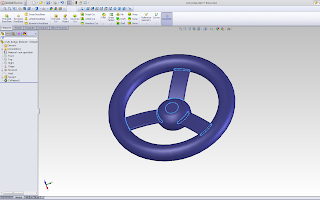This was the grate we were asked to design. It was the first time I had used the linear pattern tool before. This tool allowed me to make rows of those ovals inside the grate by merely making one and copying it upon the X and Y axis four times each.
This bracket was simple enough for me. The only part that proved difficult was the holes in the sides. I had trouble making holes in both sides because once I punctured one side the next side I tried to put a hole into would drag the the layer, and then through to the other side of the bracket. Eventually I angled it enough that it was possible to have two separate holes.
The candle holder took some time to make. The program works well with curvature but I have a hard time directing the program to do exactly what I want. The revolved base tool proved to be hand here as I struggled a little bit on my own trying to figure out how exactly to get the product I wanted.
The bowl was a simple object that required some abstract thought in my opinion. I constructed a circle within a larger circle, revolved it into a sphere, cut it in half, then hollowed it out. The result was this half circle looking bowl object!
The multi-bridge required putting several parts in place at the same time to create this design. The three bars in the middle posed an issue.
This bowling pin looked difficult at first but was actually one of the easiest designs I've done so far once a technique was derived. I used the three point arc tool to arc out from a simple circle, to arc back inwards, then out once again in a smaller fashion to create the circle at the top. After constructing the outline I simply revolved the entire design to get the pin!
The set of pins was designed in the assembly option by copying and pasting the one original bowling pin multiple times and therefore placing them in the required order. Pretty cool actually!
This is my assembled telescope. The mating process between the parts although simple proved to be aggravating as they would not go together. The design itself though was fairly simple as long as the dimensions to each piece were spaced out correctly.
Here is the shelf designed to fit into the bookshelf with the slots that were made in it. I made the shelf so that it could mate with the frame and fit right in.
This is the frame of the bookshelf. As you can see there is slits on the inside so that the shelves have the ability to slide in.
This is the completed bookshelf. After making a back to put on it, sliding the shelves in through an assembly, and making a large vase to put on top, it's completed!
This is the base and a few other parts that go to the castor assembly. A work in progress!
Simple and entertaining, here is a cube with holes in every side. The extrusion of the holes was quite easy.













